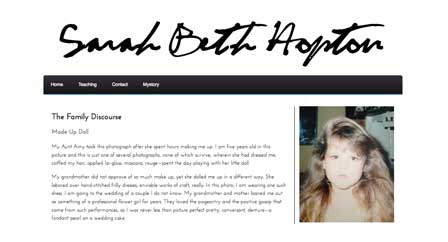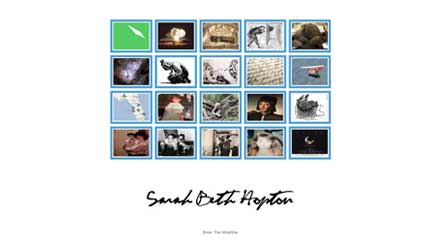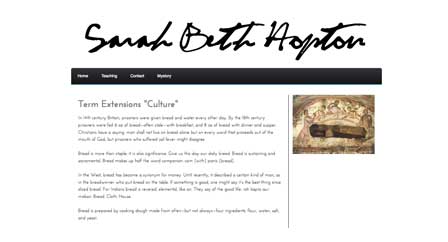Our [Electrate] Stories
Explicating Ulmer's Mystory Genre
Marc C. Santos, Ella R. Bieze, Lauren E. Cagle, Jason C., Zachary P. Dixon, Kristen N. Gay, Sarah Beth Hopton, Megan M. McIntyre
Reflection: Sarah Beth Hopton
1. What work does a mystory do?
Internet Invention (Ulmer, 2003) is informed largely by postmodern theory and, as I note below, my unfamiliarity with postmodern theory made working with the mystory genre particularly challenging. I think the mystory works in the same way that writing generally works: reflection → reflexion → action. We write to learn, to wrestle with the tropes that define us, perhaps to tell stories anew, and then to manifest change in the world (Hart-Davidson et. al, 2004). My primary complaint with the mystory genre is that there is limited direction about how to best integrate the action part of that sequence into the mystory process or product(s).
2. Does the mystory realize Gregory L. Ulmer's aspirations?
My resulting mystory highlighted the betweens and resulted in a wide emblem: the map. But, I never shook the feeling that I saw what I wanted to see. And, even if my wide emblem was the child of insight, how much and what kind of work can an emblem do beyond the metaphor? Now that I know my emblem is a map, how does that shape how I look at and respond to critical questions of social justice, the kind that Ulmer sees the EmerAgency and its egents addressing? The wide emblem wants to act like a logo, but most people won't read a mystory, they'll see it—just like most people won't read a corporate mission or vision statement. How does my wide emblem come to mean anything in the vast, expansive apparatus like the electrate? Nike's logo comes to mean something because they spend more than $13 billion per year in marketing their mystory and encouraging others to interact with if not also become a part of their story. The mystory genre is strangely silent on points of connection and interactivity. I also wonder if the kind of personal, private, reflective, narrative form of writing used to compose the mystory will be valued when compared against the depersonalized, research-driven form of academic discourse so highly prized in the first-year composition classroom today.
For me, the mystory created a kind of digital contact zone (Bizzell, 1994; Pratt, 1991), an online space where I confronted unsettling memories and aspects of self and community in order to understand how history, memory, and image influence belief, value and participation in the modern agora. The mystory became a site, possibly even a monument, where trope materialized and avenues of action became visible. Once narrative was made material, it could be deconstructed, reconstructed, and seen anew. I was, in example, unaware of how much my body was "troped" (Goncalves, 2005). If part of Ulmer's aim is to encourage students to look at the relationship of the self to the social forces moving through language that in turn shape the self, then the mystory might give students the space, exigence, and cognitive dissonance needed to do that in a way that reductive characterizations of expressivism might not. Any one of the exercises were only valuable in their relationship to other exercises in the relay, and it was only by going the distance that the hidden threads that tied them together and told a completely different story were revealed. A single reflective writing assignment, no matter how well crafted, could not achieve this. If nothing else, I like this kind of deep reflection and the writing it produces. Perhaps the mystory is the beginning of a hybrid discourse.
3. Can/should you learn Ulmer while learning HTML and CSS?
Internet Invention is grounded in classical rhetorics, but it owes just as much of its weight and power to the postmodernists. Roland Barthes, Michel Foucault, Martin Heidegger, and Gilles Deleuze inform several exercises in the text. This is both a strength and weakness of Internet Invention: a strength because postmodern theory is an important philosophical method that offers an alternative to objective and scientific rational interpretations of reality; a weakness because most undergraduate students (and some graduate students) are not well-read in postmodern thought, making the exercises difficult to unpack and unnecessarily opaque.
To help Ulmer realize his goal of creating an "image metaphysics,” students have to learn how images work on the semantic web. Students should know at least the basic language of the web—HTML—and they should know how to style the images and compositions they create using that language, which requires knowledge of CSS. But, as a matter of practice, teaching students HTML and CSS while composing a mystory is a bit like asking the first-year Spanish student to translate and then write a publishable critique of Don Quixote. As an instructor who integrates new media into her classroom, it seems to me, the work of the mystory can be done independent of learning HTML and CSS. At the least, the instructor may wish to consider teaching students HTML and CSS through a content management system to minimize frustration and maximize visual possibilities for students who do not yet have the code fluency to render what’s in their mind’s eye onto the digital canvas. It might sound obvious, but the answer to this question depends on an instructor’s course objectives and goals.
I think HTML and CSS are a language and the mystory is a conversation. It’s difficult to have a conversation with a limited vocabulary and sometimes the frustration a student feels at his inability to communicate will cause him to stop talking. If the mystory and HTML/CSS are going to be taught together, they might best be taught consecutively: vocabulary (HTML/CSS) and then conversation (mystory). Students should have plenty of time to compose the content of the mystory before they consider how to design the mystory container because the container becomes part of the mystory.
4. Should a mystory be public or private?
I chose to keep the mystory public because veiling the content is antithetical to the principles guiding the open access movement, which I fully endorse (Suber, 2012). This was a difficult decision to come by because there were moments when what I’d written left me feeling vulnerable. Yet, to hide the personal behind a password was also to shame the person in the story. If I really saw the mystory as a contact zone, then it would have been disingenuous to screen the mystory compositions or censor my voice. I struggled with this, of course. I often felt ill equipped to talk about the deeply personal or analyze it for meaning and insight in a scholarly way. I was also embarrassed and even frightened that this information might be used to exclude me from academic conversations. I was mostly scared I wouldn’t be taken seriously or worse, that I’d be labeled as overly sentimental or emotional. This is problematic for a feminist.
5. What else do you want to say?
Interestingly, one of the revelations of the mystory concerned silence, or rather, staying silent and not telling the truth. I felt that sharing this revelation was proof positive of the work the mystory could do. In the end, I framed my wide emblem. It sits on my desk and acts as a reminder to approach learning and problems from various angles. I am reminded of a quote by Gilles Deleuze and Felix Guattari (1987): “Writing has nothing to do with signifying. It has to do with surveying, mapping, even realms that are yet to come” (pp. 4-5). Looked at one way, the mystory told the story of who I was and how I’d come to be her. Looked at another, its topography took the shape of intention, informed and made visible as much by who I was as by the re:vision of who I’d like to become.
6. Did you have an aha moment?
As I critically analyzed the process of composing the mystory, what struck me as profound was my need to invent an audience and to create a sense of imagined dialogue so that I could use the text as an act of participation instead of a text that contained mere observation and reflection.
This critique should not be surprising for someone who aligns herself with the social-epistemic movement. James Berlin believed in the power of situated dialogue. He saw the English classroom as the most profound learning environment where such contextualized discourse might be discovered and voiced. Though I was unaware at the time, upon reflection, I realized that I was composing, revealing, withholding, or revising for an audience. I was creating an imaginary discourse community in which the political work of the mystory might unfold, provoke, engage, and ultimately resolve. Without this community—imaged or real—and the reading, dialogue and critical inquiry it facilitates, I felt the mystory lost its potential power as a text through which I might create a new cultural narrative instead of simply maintaining the static codes of a classroom assignment.
In fairness, and as Marc C. Santos suggested, this may not be the work of the mystory, and might better fit the work of Ulmer’s monuments. But I will say this: It was through the production, frustration, and eventual analysis of the mystory assignment that the focus of such pedagogy came into sharper relief. I believe the English classroom should be a site where students create texts that enable them to participate in a public forum relative to their own historical moment(s).


